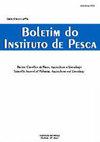Comparison between biofloc technology system and aquamimicry in the cultivation of Litopenaeus vannamei in lined ponds in Southern Brazil
IF 0.6
4区 农林科学
Q4 FISHERIES
引用次数: 0
Abstract
This work compared biofloc technology and aquamimicry technologies in Litopenaeus vannamei lined ponds, using a density of 60 shrimp·m-2. The experiment lasted 120 days, with two treatments, bioflocs (TBio) and aquamimicry (TMi), and three replications for each. In both treatments, the average values of the water quality parameters were as follows: temperature was 24.0 ± 0.32 °C, dissolved oxygen was 8.00 ± 0.45 mg·L-1, pH was 8.40 ± 0.20, and alkalinity was 240.01 ± 37.15 mg·L-1. The control of water quality was effectively maintained in both treatments, indicating the aquamimicry system’s capability to efficiently recycle the nutrients found in the lined ponds’ water. Furthermore, both treatments demonstrated efficiency in shrimp production, and the shrimp from the TMi treatment reached an average final weight of 11.73 ± 2.21 g, average survival of 53.3 ± 15.2%, and productivity of 3.56 ± 0.15-ton·ha-1. The TBio shrimp reached a final weight of 11.48 ± 1.25 g, survival of 63.3 ± 8.16%, and productivity of 4.08 ± 1.10-ton·ha-1. The present study demonstrated that TMi treatment pondspresented zootechnical performances close to those of TBio treatment ponds. The results achieved can contribute to the improvement of this cultivation system to use it in higher stocking densities.巴西南部成行池塘养殖凡纳滨对虾生物絮团技术体系与水生生态的比较
本研究采用密度为60只·m-2的凡纳滨对虾(Litopenaeus vannamei)池塘,比较了生物絮团技术和水生生态技术。试验期120 d,分生物絮团(TBio)和水生生物(TMi) 2个处理,每个处理3个重复。两个处理的水质参数平均值为:温度24.0±0.32℃,溶解氧8.00±0.45 mg·L-1, pH 8.40±0.20,碱度240.01±37.15 mg·L-1。两种处理都能有效地控制水质,这表明共生系统能够有效地回收内衬池塘水中的营养物质。两种处理均能提高对虾的产量,TMi处理对虾的平均末重为11.73±2.21 g,平均成活率为53.3±15.2%,产量为3.56±0.15 t·ha-1。TBio对虾最终体重为11.48±1.25 g,成活率为63.3±8.16%,产量为4.08±1.10 ton·ha-1。本研究表明,TMi处理池的动物技术性能与TBio处理池接近。所取得的结果有助于改进该栽培系统,以便在更高的放养密度下使用。
本文章由计算机程序翻译,如有差异,请以英文原文为准。
求助全文
约1分钟内获得全文
求助全文
来源期刊

Boletim do Instituto de Pesca
FISHERIES-ZOOLOGY
CiteScore
0.80
自引率
0.00%
发文量
24
审稿时长
>12 weeks
期刊介绍:
To publish original articles of research and short communications in the following áreas: Fisheries, Aquaculture, Zootechnology, Limnology, Oceanography, Biology and Pathology of aquatic organisms. The publication depends on the approval of the Editorial Board, based on the peer review.
 求助内容:
求助内容: 应助结果提醒方式:
应助结果提醒方式:


